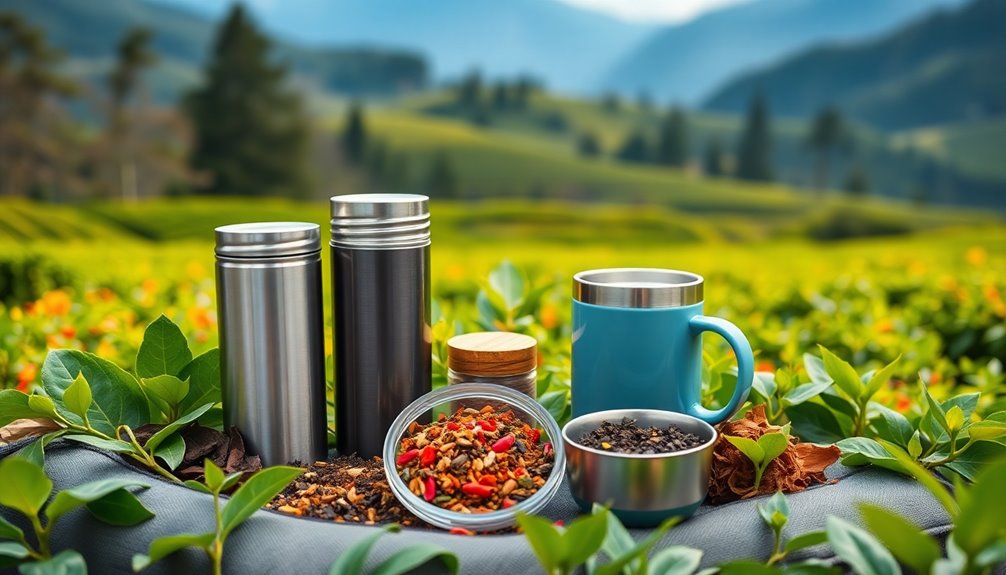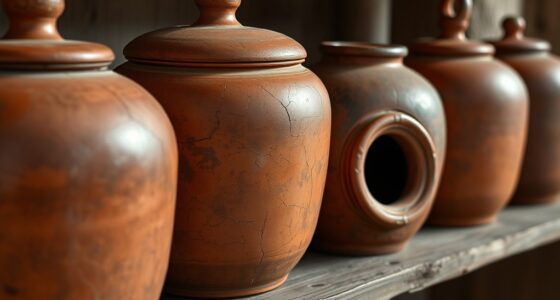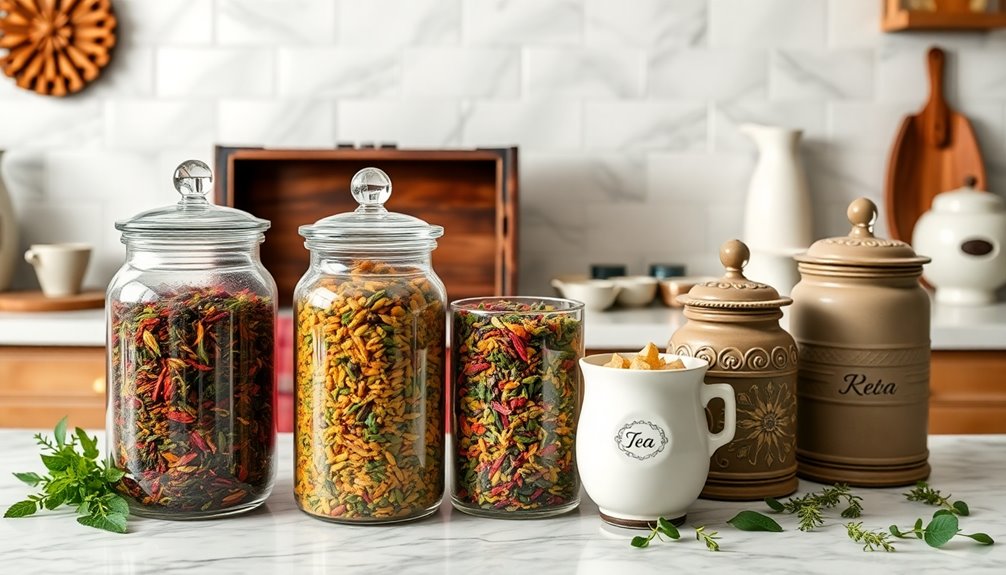If your tea smells flat, musty, or cardboard-like, it’s a clear sign it’s gone stale. You might notice a dull appearance or crumpled leaves, and the brew could turn out pale, weak, or flat-tasting. A loss of aroma and a lack of depth in flavor also indicate deterioration. To fix or prevent this, store your tea in airtight containers in a cool, dark place. Keep exploring to discover more tips for prolonging your tea’s freshness.
Key Takeaways
- The tea has a flat, musty, or cardboard-like aroma, indicating flavor loss.
- The brew appears pale, weak, or thin, signaling diminished essential oils and flavor.
- The leaves are dull, crumpled, or broken, showing signs of aging and deterioration.
- The aroma and taste are dull, lifeless, or bitter, reflecting stale flavor.
- Proper storage, such as airtight containers kept in a cool, dark place, can help prevent and fix staleness.

Have you ever poured a cup of tea only to find it tastes flat or dull? If so, you might be dealing with tea that’s gone stale. Tea storage plays a key role in maintaining freshness, and poor storage can accelerate flavor deterioration. When tea isn’t stored properly, it’s exposed to elements like air, moisture, heat, and light, all of which can cause the tea’s delicate flavors to fade. Over time, these factors lead to a loss of aroma and taste, making your once vibrant brew dull and unappealing. Understanding how to identify these signs and how to fix them can help you enjoy your tea at its best.
One of the most noticeable signs your tea has gone stale is a significant change in aroma. Fresh tea typically has a strong, inviting scent that hints at the flavors within. If your tea smells flat, musty, or like cardboard, it’s a clear indicator that flavor deterioration has occurred. This is especially true for loose leaf teas, which are more susceptible to losing their aroma when exposed to air or light. Similarly, if your tea’s flavor is muted or lacks the usual brightness and complexity, it’s a sign that it’s past its prime. You might notice a dull, lifeless taste that doesn’t match the vibrant notes you expect from a fresh brew.
Another clue is the texture and appearance of your tea. For instance, stale tea leaves may look dull or crumpled, and they might lose their original shape. If you’re brewing a bag, the tea may produce a weak infusion, with a pale color and thin body. This often correlates with flavor deterioration, as the tea’s essential oils and compounds have evaporated or degraded over time. Additionally, if your tea tastes flat or bitter without the complexity of well-preserved leaves, it’s a sign that the freshness has declined. Proper storage, such as keeping tea in airtight containers, can prevent flavor loss and extend its shelf life.
Fortunately, you can often fix or prevent these issues by improving your tea storage habits. Store your tea in airtight containers, away from light, heat, and moisture. Keep it in a cool, dark place—like a pantry or cupboard—rather than in the fridge, where moisture can compromise quality. Proper storage slows down flavor deterioration, helping your tea retain its aroma and taste for longer. If your tea has already gone stale, it’s best to use it in cooking or as a base for iced tea rather than drinking it hot, where its flat notes might be more noticeable. With mindful storage and attention to these signs, you can enjoy fresh, flavorful tea every time.
Frequently Asked Questions
Can I Still Drink Tea That Smells Off?
If your tea smells off, it’s best not to drink it. Smell is a key freshness indicator, so trust your nose. Proper tea storage tips, like keeping it in an airtight container away from light and moisture, help maintain flavor and safety. Drinking stale tea might cause an upset stomach or taste unpleasant. When in doubt, it’s safer to discard the tea and brew fresh for the best experience.
How Long Does Brewed Tea Stay Fresh?
You wonder how long brewed tea stays fresh, don’t you? Well, if you store it properly, typically in the fridge, it lasts about 3 to 5 days. Keep an eye on freshness indicators—like a sour smell or off-taste—that tell you it’s time to toss it. Proper tea storage guarantees your brew stays flavorful longer, but don’t ignore those signs; your health and taste buds will thank you.
Does the Type of Tea Affect Staleness?
The type of tea definitely affects staleness because different teas have varying sensitivities to air, light, and moisture. To preserve freshness, you should store your tea properly, using airtight containers and keeping them in a cool, dark place. Proper tea storage helps maintain flavor and aroma longer. For example, green teas are more delicate and need quicker consumption, while black teas last longer if stored correctly.
Can Brewing Methods Prevent Tea From Becoming Stale?
A stitch in time saves nine, so proper brewing techniques can help keep your tea fresh longer. You prevent staleness by using the right tea storage, keeping it airtight and cool. Brewing methods matter too; avoid over-steeping or using hot water for too long, which can accelerate spoilage. These steps make certain your tea stays flavorful and aromatic, making every cup a satisfying experience rather than a stale disappointment.
Is It Safe to Consume Tea Past Its Expiration Date?
You might wonder if it’s safe to consume tea past its expiration date. Generally, tea remains safe, but poor tea storage can lead to flavor deterioration over time. If your tea has been stored properly in a cool, dry place, it’s likely still safe, though the taste may decline. Always check for off smells or mold before drinking, and trust your senses to decide if it’s still good.
Conclusion
Now that you know the signs of stale tea, you’ll never have to wonder if your brew is past its prime. Remember, fresh tea can elevate your entire experience, so don’t settle for dull flavors. When was the last time you truly enjoyed a perfect cup? Take a moment to check your tea stash—freshness matters, and your taste buds deserve it. After all, isn’t quality tea worth the extra effort?










